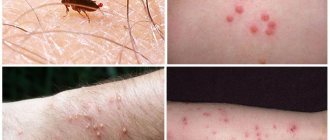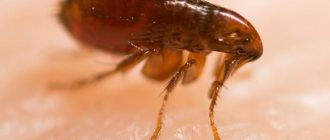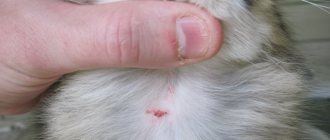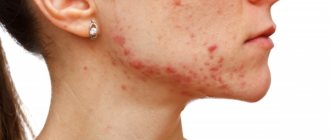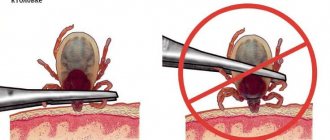Animals, like humans, are susceptible to various diseases, regardless of species, breed or size. Illnesses can affect not only wild fauna, but also pets living in an apartment.
The most common nuisance among animals is fleas, which are most often found in long-haired pets, such as cats. This, in turn, can cause inflammation - an allergy to the saliva of parasites. Moreover, for its development, just one flea bite is enough, because the saliva of these parasites contains many types of allergens to which cats are very sensitive.
Important: the disease can occur not only in long-haired breeds, but also in animals with short hair and even hairless ones.
Why does flea dermatitis develop in cats?
Individuals older than 1 year are more often susceptible to this disease than kittens under 12 months. But in the second case, the invasion almost always ends in death. The reason is weak immunity, which often cannot cope with the disease.
This kind of skin inflammation in cats doesn’t just happen. The most common causes of the disease are:
- warm season;
- dirt from the street;
- unsanitary conditions;
- contact with other animals;
- decreased immunity;
- self-walking
The peak of diseases occurs in the summer season, when the air temperature reaches its maximum, which provokes an increase in the activity of parasites. This usually happens in July-August. At this time of year, it is extremely undesirable to let your pets outside. Especially when it comes to southern cities. For a disease such as flea allergy in cats, Rostov-on-Don, Krasnodar, Anapa and other settlements in the southern regions are an ideal place for spread.
Fleas that cause the disease can enter the house, for example, with dirt on the soles or on outer clothing.
Outdoor animals, which are almost always infested with fleas, are especially dangerous for cats living in apartments. Therefore, walking pets on the street should only be done under close attention and on a harness. It is for this reason that self-walking cats should be reduced in time as much as possible, especially in the summer.
But not all pets, even if they have fleas, can become infected with this disease. Usually it is dangerous only for those cats that have a decrease in immunity. Most often this happens after an illness, as a result of which the protective functions of the animal’s body are significantly reduced.
Course of allergies
All types of reactions to pets follow the same pathway. At the first contact with an allergen, the body is sensitized, the substance is recognized by the immune system and class E antibodies are formed. Immunoglobulins are absorbed on the surface of cell membranes, making them susceptible to allergens. In the future, this is what plays a key role in the course of the disease.
During subsequent contacts, the allergens are bound by IgE (class E antibodies). This makes immunocompetent cells active and activates the release of histamine and some other substances into the intercellular space. This helps to dilate blood vessels and increase the volume of intercellular fluid, irritating sensitive nerve endings.
Symptoms: descriptions and photos
All diseases have distinctive signs. Dermatitis in cats is no exception.
Home diagnostics
In most cases, you can identify the presence of fleas in a cat yourself. To do this, you just need to watch your pet for a while.
If you want to make sure that your cat is allergic to fleas, it is recommended to pay attention to the following:
- severe itching, especially in the head and tail area;
- redness;
- blisters;
- swelling at the site of the wound;
- anxiety, mainly at night;
- a cat scratching certain areas until they bleed;
- regular biting (the animal can bite itself).
Fleas are also easy to spot if you carefully examine the fur and skin. The presence of parasites can also be indicated by small black dots - excrement that look like beads.
To find out that this is not just dirt, but flea waste, you just need to dip one of them in a glass of water. If it has dissolved and the liquid has turned a slightly light brown color, you can be sure that the cat is infected.
In cats, a flea allergy has the following symptoms:
- the presence of ulcers or dense nodules;
- excessive dryness of the skin;
- partial swelling in certain places;
- severe scratching (sometimes to the point of bleeding);
- high temperature of certain areas of the skin;
- presence of problems with digestion and appetite;
- excessive fearfulness;
- frequent meowing.
Important: the above signs may be signs of other diseases, so to make an accurate diagnosis and choose the right treatment, you should first consult a veterinarian.
How does the cat react to this?
The cat, in response to intense itching, tries to lick, scratch or bite the affected areas. This causes hair loss and can lead to open sores or scabs on the skin, which can lead to the development of a secondary bacterial infection. The most susceptible area is on the back near the tail and should be checked for allergies. Additionally, numerous small scabs may appear around the head and neck. These scabs are often called miliary lesions. This term is coined because the scabs look like grains of wheat.
Forms of allergies to parasites
Divided into three types:
- acute;
- subacute;
- chronic.
They all have their own characteristics and characteristics, thanks to which the stage can be determined. In the acute form, the disease passes quickly and is accompanied by severe itching, which gives the cat a lot of discomfort. Due to regular combing, the hair may fall off in clumps, and in its place bald areas, often covered with a crust, may appear. With this form of the disease, the cat has parasites in its fur.
If treatment is not started on time, the acute form quickly becomes chronic, which is an intermediate stage between the first and third stages. There may no longer be fleas.
The chronic form is characterized by the presence of signs of both stages. This period of the disease may be accompanied by itching, redness, and then its sudden disappearance. Usually this process is recurrent in nature, because periodically there is an improvement or deterioration in the animal’s condition. The chronic stage is already difficult to respond to medications, so its treatment must be approached comprehensively and only under the supervision of a doctor.
Diagnosis at the veterinarian
If it is difficult to identify the problem yourself, it is advisable to visit a clinic where they will make a diagnosis and determine the stage.
When visiting a doctor, be prepared to provide information about the course of the disease, its main signs and the cat’s behavior. If the inflammation has already started, it will be useful to show the specialist a photo of the initial stage so that he can make an accurate diagnosis. This will allow the doctor to prescribe the correct treatment depending on the animal’s health condition.
A veterinarian can determine the disease in the following ways:
- Technique for combing wool onto white paper . To do this, the doctor uses a comb to remove a scrap from a small area of the cat’s body onto white paper slightly moistened with water. The presence of parasites is indicated by small dark dots around which a spot forms.
- Blood analysis . When this disease is detected in an animal, cells (eosinophils) are found that are involved in hypersensitivity reactions. In this case, their concentration is noticeably increased.
- By visual inspection . As a result, allergies, baldness in certain areas, dried crusts with blood, ear mites, fungal diseases and others may appear.
Treatment of dermatitis in cats
If your veterinarian has diagnosed flea dermatitis in cats, treatment should begin immediately to prevent it from progressing to a serious stage.
You need to start acting by eliminating the root cause - parasites. To remove fleas, you can use various methods - both folk remedies and products sold in pharmacies.
Antihistamines
They are aimed at eliminating signs of allergies - itching, swelling, redness. Typically, the duration of taking such medications does not exceed one to three weeks. Only a veterinarian can calculate the duration.
For convenience, they are usually mixed with food or water. Some anti-allergy drops and tablets suitable for humans can also be given to animals. These, for example, include Zodak, Suprastin or Zyrtec. In particularly severe cases, the doctor may prescribe injections.
Important: antihistamines are effective only with complex treatment. They do not eliminate the cause, but only help remove the symptoms.
Hormonal
They are usually prescribed for severe cases of the disease and are first given in large quantities to dull the manifestations of the disease, gradually reducing the dose.
Hormonal medications have a lot of side effects, so they are given only when other treatments are useless. Such troubles include:
- decreased immune function of the body;
- metabolic disease;
- problems with the digestive tract.
Because medications in the form of tablets or drops are difficult to administer to cats, creams and gels that are used externally, such as Stop Itching, are sometimes prescribed as an alternative.
Diet
To restore strength after an illness, an animal needs special cat food that will help it support its immune system. Food high in Omega-3 should be given as an additional nutrition to the main one. It is also necessary to completely exclude chicken, beef, lamb and food made from these products for a while - due to strong allergenicity.
Drops
They are usually used to eliminate the cause of dermatitis in cats - fleas. They are applied externally - to the withers, so that the animal does not remove the medicine when licking the fur. In addition, it is unacceptable for it to enter the animal’s body.
The drops are convenient because a small dose is required to remove all types of skin parasites; they allow you to get rid of them as quickly as possible, literally within 1-2 days from the moment of application. Such drops include, for example, “Beafar”, “Frontline” or “Advantage”.
Powder
It is used to heal sores caused by scratches on the body of an animal. When using it, the crusts heal faster, and clean and healthy skin appears in their place. In addition, the composition of the powder is aimed at reducing itching, which also has a beneficial effect on wound healing.
Collar
It is the most common type of treatment for parasites in cats. True, such a flea trap is more used for prevention, because it does not allow them to settle on the cat’s skin, repelling them with their specific smell.
And the composition with which the material is impregnated can also cause allergies, but the risk of its occurrence is much lower than flea infestation. The most common are “Bars” and “Clandestine”.
Shampoo
During the treatment process, most veterinarians, along with other methods, prescribe the use of special shampoos. Their composition is more aggressive than regular ones, because it is aimed at destroying parasites. It is recommended to use them only for pets older than six months. Cats younger than this age should be treated with different techniques. The most popular brands among such shampoos are “Clandestine”, “Lugovoy” and “Mskiss”.
Spray
To get rid of fleas and the consequences of their life on the animal's body, sprays are often prescribed (Bolfo, Bars, Frontline). The advantage of using this drug is that it covers a large area of the affected area and penetrates into its deepest layers. In addition, the spray is usually sold in large quantities, which allows it to be used for more than one month.
What is an allergy and how does it affect a cat?
Allergies occur when a cat's immune system reacts to foreign substances called allergens or antigens. Allergens and antigens are foreign proteins that the immune system tries to get rid of. An acute reaction manifests itself in one of three ways:
- The most common manifestation is itchy skin, either localized to one area or a general reaction throughout the cat's body;
- Another manifestation affects the respiratory system and may result in coughing, sneezing and wheezing. Sometimes there may be discharge from the nose or eyes;
- The third manifestation is related to the digestive system, resulting in vomiting, flatulence or diarrhea.
Traditional methods of treating allergies to flea bites
In case of mild disease, traditional methods can be used to eliminate ectoparasites.
- Use of needles for bedding . Fleas are repelled by this smell, so it is advisable to replace your pet’s sleeping place with a mattress stuffed with pine needles.
- Salt . Pour half a pack of salt into a bowl of warm water and bathe the animal in this solution. As a rule, several such procedures are necessary to achieve maximum results. It is important to ensure that water does not get into your cat's eyes. Such procedures cannot be performed if there are open wounds on the animal’s body.
- Garlic . The smell of this vegetable is known to repel many types of parasites, including fleas. To prepare the mixture, you need to pass 2-3 slices through a special press, add half a glass of warm water and let it brew for 6-10 hours. Gently rub the resulting solution into your pet’s skin and allow to dry.
- Essential oils with the scent of lavender and cedar . To do this, make a medicinal solution: add 3 drops of lavender and cedar oil to 0.5 liters of warm water. Then shake well and spray over the cat's fur using a spray bottle. This procedure should be carried out 2-3 times a day until all parasites disappear.
Treating scratches at home
Self-medication for flea dermatitis is unacceptable, but primary therapy can be started at home.
the washing up
The animal is washed and treated with flea control. Fleas and their larvae are combed out with a fine comb. For prevention, after treatment, a special anti-parasitic collar is worn.
If there are bleeding wounds on the skin, they can be treated along the edges with iodine and tetracycline ointment. If there is pus, an antibiotic is needed - you cannot select it yourself - only on the recommendation of a doctor.
Important! To protect the animal from poisoning, all products must be thoroughly washed out of the fur. To avoid licking, you can use a special collar.
Prevention
To minimize the risk of the disease, special attention should be paid to its prevention.
In order to prevent the occurrence of dermatitis in cats, the following measures must be taken:
- Keep the house clean. To do this, every time you come home from the street, you need to wash your shoes and clean your outerwear. After these manipulations, you should put things in a closed space, for example, a closet.
- The cat should wear a neck strap regularly. It is an excellent remedy for repelling skin parasites, because its composition is aimed specifically at destroying them. In addition, such a device is the most inexpensive method to protect your pet from fleas.
- Avoid self-walking of the animal, especially in the warm season.
- Periodically carry out a preventive examination of the cat's skin for the presence of parasites.
- Visit your veterinarian regularly.
- Do not violate the flea treatment schedule (2 times a year).
When a disease such as flea allergic dermatitis is detected in cats, timely treatment plays a huge role, since its health condition depends on the speed of reaction of the animal’s owners.
What about vaccinations?
Immunotherapy is used in an attempt to reprogram the cat's immune system.
Flea saliva extract (flea antigen) is administered to the cat in small quantities over a long period. This immunotherapy is used in an attempt to reprogram a cat's immune system so that it no longer overreacts to flea bites. If successful, the cat will no longer itch when bitten by a flea, or it will become less intense. This therapy is successful in approximately half of the cases.
